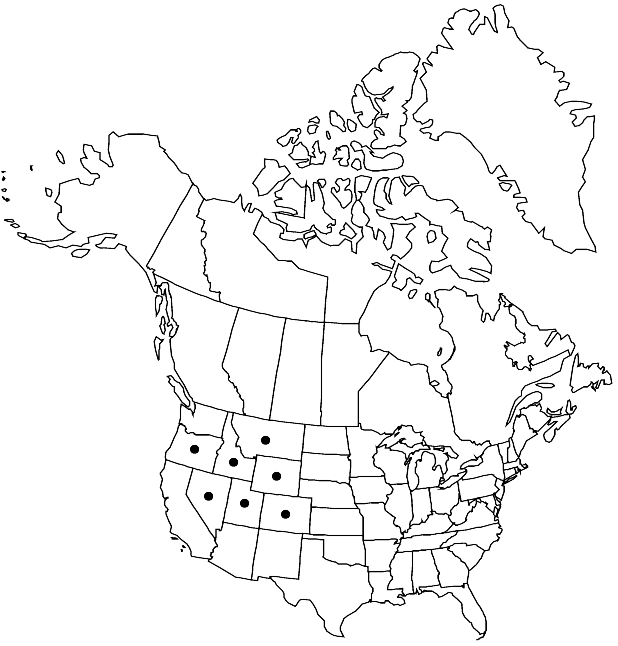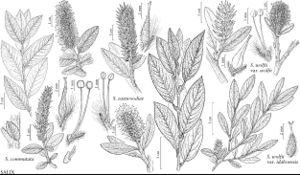Difference between revisions of "Salix wolfii"
in J. T. Rothrock, Rep. U. S. Geogr. Surv., Wheeler, 241. 1879.
FNA>Volume Importer |
RevisionBot (talk | contribs) m (Bot: Adding category Revised Since Print) |
||
| (5 intermediate revisions by 3 users not shown) | |||
| Line 1: | Line 1: | ||
{{Treatment/ID | {{Treatment/ID | ||
|accepted_name=Salix wolfii | |accepted_name=Salix wolfii | ||
| − | |accepted_authority=Bebb | + | |accepted_authority=Bebb |
|publications={{Treatment/Publication | |publications={{Treatment/Publication | ||
|title=in J. T. Rothrock, Rep. U. S. Geogr. Surv., Wheeler, | |title=in J. T. Rothrock, Rep. U. S. Geogr. Surv., Wheeler, | ||
| Line 8: | Line 8: | ||
}} | }} | ||
|common_names=Idaho willow | |common_names=Idaho willow | ||
| + | |special_status={{Treatment/ID/Special_status | ||
| + | |code=F | ||
| + | |label=Illustrated | ||
| + | }}{{Treatment/ID/Special_status | ||
| + | |code=E | ||
| + | |label=Endemic | ||
| + | }} | ||
|basionyms= | |basionyms= | ||
|synonyms= | |synonyms= | ||
| Line 20: | Line 27: | ||
-->{{Treatment/Body | -->{{Treatment/Body | ||
| − | |distribution= | + | |distribution=Colo.;Idaho;Mont.;Nev.;Oreg.;Utah;Wyo. |
|discussion=<p>Varieties 2 (2 in the flora).</p><!-- | |discussion=<p>Varieties 2 (2 in the flora).</p><!-- | ||
| − | --><p>The two varieties of <i>Salix wolfii</i> are distinguished mainly by ovary hairiness; other characters in the key overlap. Ovaries of the typical < | + | --><p>The two varieties of <i>Salix wolfii</i> are distinguished mainly by ovary hairiness; other characters in the key overlap. Ovaries of the typical <i></i>var.<i> wolfii</i> are glabrous and those of <i></i>var.<i> idahoensis</i> are hairy. In the latter variety, ovaries are sometimes hairy throughout, but most have hairs in streaks or in a patch at the base of the ovary and on the stipes. These plants usually do not set seed and may be infertile hybrids. Occasional occurrence of staminate flowers with abaxial nectaries suggests that this variety may be a hybrid with <i>S. glauca</i> or <i>S. brachycarpa</i>, although it could also be with <i>S. eastwoodiae</i>, as suggested by S. J. Brunsfeld and F. D. Johnson (1985). The presence of both abaxial and adaxial nectaries in staminate flowers of <i>S. wolfii</i> (staminate plants cannot be identified to variety) is an unusual character in subg. Vetrix; it rarely occurs in <i>S. argyrocarpa</i>, <i>S. breweri</i>, and <i>S. orestera</i>, but is common in <i>S. wolfii</i>. Both hairy ovaries and abaxial nectaries could have been acquired through hybridization and introgression, or polyploidy, with <i>S. glauca</i> or <i>S. brachycarpa</i>. Cytological study of <i>S. wolfii</i> may help answer this question.</p> |
|tables= | |tables= | ||
|references= | |references= | ||
| Line 45: | Line 52: | ||
-->{{#Taxon: | -->{{#Taxon: | ||
name=Salix wolfii | name=Salix wolfii | ||
| − | + | |authority=Bebb | |
| − | |authority=Bebb | ||
|rank=species | |rank=species | ||
|parent rank=section | |parent rank=section | ||
| Line 52: | Line 58: | ||
|basionyms= | |basionyms= | ||
|family=Salicaceae | |family=Salicaceae | ||
| − | |distribution= | + | |distribution=Colo.;Idaho;Mont.;Nev.;Oreg.;Utah;Wyo. |
|reference=None | |reference=None | ||
|publication title=in J. T. Rothrock, Rep. U. S. Geogr. Surv., Wheeler, | |publication title=in J. T. Rothrock, Rep. U. S. Geogr. Surv., Wheeler, | ||
|publication year=1879 | |publication year=1879 | ||
| − | |special status= | + | |special status=Illustrated;Endemic |
| − | |source xml=https:// | + | |source xml=https://bitbucket.org/aafc-mbb/fna-data-curation/src/2e0870ddd59836b60bcf96646a41e87ea5a5943a/coarse_grained_fna_xml/V7/V7_107.xml |
|genus=Salix | |genus=Salix | ||
|subgenus=Salix subg. Vetrix | |subgenus=Salix subg. Vetrix | ||
| Line 64: | Line 70: | ||
}}<!-- | }}<!-- | ||
| − | -->[[Category:Treatment]][[Category:Salix sect. Hastatae]] | + | --> |
| + | |||
| + | [[Category:Treatment]] | ||
| + | [[Category:Salix sect. Hastatae]] | ||
| + | [[Category:Revised Since Print]] | ||
Latest revision as of 17:16, 6 November 2020
Plants 0.1–2 m. Stems: branches red-brown, violet, yellow-gray, or yellow-brown, pubescent or pilose to glabrescent; branchlets yellowish, yellow-brown, red-brown, or yellow-green, sparsely or moderately densely pubescent, or densely long-silky, (inner membranaceous bud-scale layer free, separating from outer layer). Leaves: stipules rudimentary or foliaceous on early ones, foliaceous on late ones, apex rounded, acuminate, or acute; petiole convex to flat, or shallowly grooved adaxially, 3–12 mm, pubescent, long-silky, or villous adaxially; largest medial blade narrowly oblong, narrowly elliptic, elliptic, or oblanceolate, 26–56 × 8–16.5 mm, 2.5–3.7–5.6 times as long as wide, base cuneate, convex, or rounded, margins flat, entire, apex acute, acuminate, or convex, abaxial surface not glaucous, pubescent, short-silky, or villous, hairs appressed or spreading, straight or wavy, adaxial dull, sparsely to densely silky or villous; proximal blade margins entire; juvenile blade yellowish green, densely short- or long-silky or villous abaxially, hairs white. Catkins flowering as leaves emerge; staminate stout or subglobose, 9.5–16 × 6–12 mm, flowering branchlet 1–5.5 mm; pistillate moderately or very densely flowered, stout, subglobose or globose, 8.5–38 × 5–12 mm, flowering branchlet 1–11 mm; floral bract brown, black, or bicolor, 0.8–2 mm, apex rounded or acute, abaxially hairy, hairs wavy, straight, or curly. Staminate flowers: (abaxial nectary 0–0.2 mm), adaxial nectary oblong, 0.4–1.1 mm, (nectaries distinct); filaments distinct, glabrous; anthers yellow, 0.3–0.5 mm. Pistillate flowers: adaxial nectary oblong, ovate, or flask-shaped, 0.4–1.1 mm, shorter to longer than stipe; stipe 0.2–0.9 mm; ovary pyriform, glabrous or hairy, beak gradually tapering to or slightly bulged below styles; ovules 8–16 per ovary; styles 0.3–1 mm; stigmas flat, abaxially non-papillate with rounded or pointed tip, or slenderly or broadly cylindrical, 0.24–0.3–0.4 mm. Capsules 3–5 mm.
Distribution

Colo., Idaho, Mont., Nev., Oreg., Utah, Wyo.
Discussion
Varieties 2 (2 in the flora).
The two varieties of Salix wolfii are distinguished mainly by ovary hairiness; other characters in the key overlap. Ovaries of the typical var. wolfii are glabrous and those of var. idahoensis are hairy. In the latter variety, ovaries are sometimes hairy throughout, but most have hairs in streaks or in a patch at the base of the ovary and on the stipes. These plants usually do not set seed and may be infertile hybrids. Occasional occurrence of staminate flowers with abaxial nectaries suggests that this variety may be a hybrid with S. glauca or S. brachycarpa, although it could also be with S. eastwoodiae, as suggested by S. J. Brunsfeld and F. D. Johnson (1985). The presence of both abaxial and adaxial nectaries in staminate flowers of S. wolfii (staminate plants cannot be identified to variety) is an unusual character in subg. Vetrix; it rarely occurs in S. argyrocarpa, S. breweri, and S. orestera, but is common in S. wolfii. Both hairy ovaries and abaxial nectaries could have been acquired through hybridization and introgression, or polyploidy, with S. glauca or S. brachycarpa. Cytological study of S. wolfii may help answer this question.
Selected References
None.
Lower Taxa
Key
| 1 | Ovaries glabrous; pistillate adaxial nectaries 0.4-0.8 mm; stipes 0.2-0.9 mm. | Salix wolfii var. wolfii |
| 1 | Ovaries pubescent or tomentose (hairs in streaks or patches); pistillate adaxial nectaries 0.4-1.1 mm; stipes 0-0.4 mm | Salix wolfii var. idahoensis |
